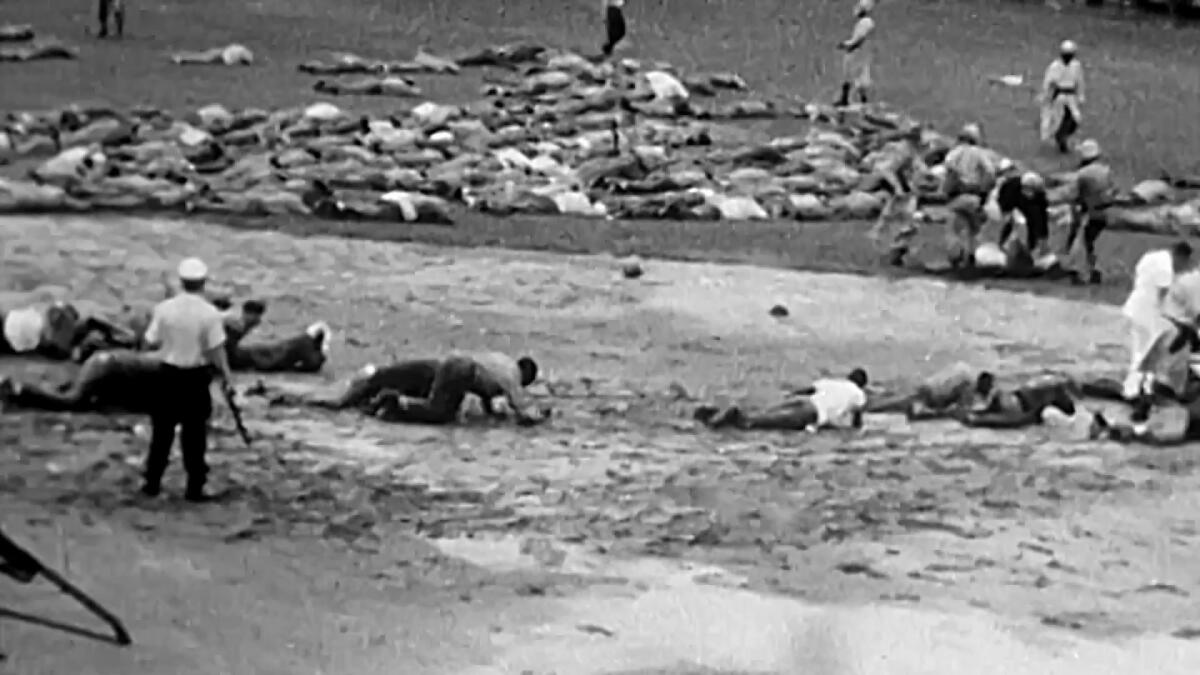Review: The documentary ‘Attica’ will rattle and upset you. And it should

The Times is committed to reviewing theatrical film releases during the COVID-19 pandemic. Because moviegoing carries risks during this time, we remind readers to follow health and safety guidelines as outlined by the Centers for Disease Control and Prevention and local health officials.
The saying goes that history is written by the victors, and perhaps that’s why what happened at the Attica Correctional Facility in September 1971 is so often referred to as a “riot.” After a five-day standoff between Attica prisoners, the staff they took hostage and the New York State Police who raided the prison, 43 people died — and a certain narrative of what happened took hold, one that was shaped by racism, bias and misplaced trust.
Decades later, at a time when urgent conversations about prison reform and police brutality continue to grip this country (with very little accommodation from the powers that be), filmmaker Stanley Nelson’s documentary “Attica” peels back what happened that week with methodical precision, revealing interviews and immersive atmospherics. It will rattle and upset viewers, and it should. “Attica” is an insightful, provocative work that contextualizes how those operating the facility not only enable but encourage racism and dehumanization, have done so for decades and continue to do so today. “They’re just waiting to kill us,” one of the men says of the tension between inmates and the police, and it’s a statement that undoubtedly some viewers will nod along with, in recognition and resignation, 50 years later.
The Attica prison riot — referred to more often in this documentary as an “uprising,” an intentional word choice that Nelson unpacks and stands by — has a certain pop-culture lore. In Sidney Lumet’s 1975 film “Dog Day Afternoon,” Al Pacino’s Sonny Wortzik, a character inspired by real-life bank robber John Wojtowicz, yells “Attica! Attica!” when police attempt to swarm him. (The line was improvised by an assistant director, Pacino says.) Comedy series like “The League” would satirize it, but the moment’s power is in its invocation of outrage and solidarity for the oppressed, the controlled and the mistreated.
The documentary “Attica” takes a similar approach, and uses a dense array of archival and surveillance footage, new interviews with inmates and townspeople, contemporaneous news coverage and commentary (including audio of then-President Richard Nixon asking then-Gov. Nelson Rockefeller, “Are these primarily Blacks that you’re dealing with?”), and still photographs of the event’s aftermath. The last are gory and grotesque, images that are unshakable, stark, and maybe even cross the line in driving home the gleeful violence employed by the police. But Nelson isn’t exactly concerned with whether viewers are uneasy — perhaps they should be, he argues. If discomfort is the only thing audiences feel when considering legacies of American cruelty, they’ve had an easier time of it than most, in particular than the men featured in “Attica.”
Situated 250 miles from New York City, Attica, N.Y. is a town whose economy is supported almost entirely by its prison. With a population of a few thousand in 1971, most of the males worked there, and most families knew each other. It was practically a closed community — much like the prison itself — but with far different living conditions. As uprising survivor Jorge “Che” Nieves says, “Something always was ready to happen at Attica. The population was tired. Tired of lies, of promises. We were tired.” And “Attica” doesn’t waste much time, immediately leaping into the bubbling frustration that led to an attack on a guard, to a broken door and stolen keys, and to inmates unlocking each other and coalescing in the central hub of the prison, nicknamed “Times Square.”
The events of what the film identifies as “Thursday — Day 1” set up a dichotomy that would continue for days. On one side, the prisoners demanding change and the outsiders who came to help with negotiations between them and police; on the other, the hostages’ families, reporters and authorities who seized upon the uprising and further inflamed it. Nelson plainly introduces all parties and gives each a chance to speak, bringing together an array of voices to reflect the totality of the situation.
The survivors, who with a mixture of pride and nostalgia explain how they divided up Times Square, with elections that led to inmates’ representatives such as Elliott James “L.D.” Barkley and head of security Frank “Big Black” Smith, who voiced their demands to be “treated like human beings.” The prison guards’ family members, whose lingering bitterness infuses their memories of waiting for news on their relatives. Amsterdam News publisher Clarence Jones, who was invited into Attica to share the prisoners’ requests for expanded visitation privileges, better food and healthcare, religious freedom, and higher wages with the watching world — and who would quickly realize how unbending “the naked fist of power … law and order” is to any challenge to its authority.
Nelson deftly arranges all these varying perspectives to cannily drive home a recurring point: that the opinions of those affected by the uprising, and interviewed in “Attica,” have not changed. The Attica survivors who thought their cause was just still do so, and the people who saw the Attica prisoners as less than human still do so. Certain ideologies about who deserves human rights and who doesn’t are still entrenched among us, and because of that intractability, challenging such narrowness becomes even more vital. “Attica” is a jarring, engrossing and enraging reminder of how those in power will lie, humiliate, kill and cover up to retain it, and the documentary is one of the year’s best.
'Attica'
Not rated
Running time: 1 hour, 58 minutes
Playing: Starts Oct. 29, Laemmle Monica, Santa Monica; available Nov. 6 on Showtime
More to Read
Only good movies
Get the Indie Focus newsletter, Mark Olsen's weekly guide to the world of cinema.
You may occasionally receive promotional content from the Los Angeles Times.










